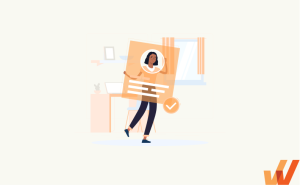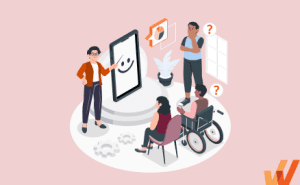Over the past decade, online learning has replaced traditional face-to-face learning as the most common training content delivery method, from classroom settings to employee training.
COVID accelerated the transition to online learning as the preferred style of learning and it has continued to displace traditional in-person formal learning over the following years. With flexible self-paced learning tools providing information at one’s fingertips, online learning has become the go-to classroom and employee training method option.
Despite its growing preference among learners, the question remains—is online learning as effective as traditional, face-to-face learning? While each undoubtedly has its pros and cons, is one better than the other?
In this article, we explore the key advantages and disadvantages of online learning and face-to-face learning. We’ll then compare the key differences between the two learning methods to help determine which one is the most effective for organizations and learners.
What Is Online Learning?
Any learning that occurs online via a web browser is considered online learning (or eLearning). Today, virtual learning is most often used to refer to asynchronous learning, which allows learners to engage with instructional material at their own pace, from anywhere, available at any time.
Online learning encourages self-paced education and can be referred to as anything from a remote learning course on LinkedIn Learning to a full-fledged, virtual college degree program. Learning management systems create and publish courses in classroom and corporate learning settings, connect learners and learning materials, monitor progression, and assess performance.
Benefits of online learning
eLearning presents clear advantages for learning and development professionals, end-user learners, educational institutions, and enterprise organizations. Those include:
- It is more cost effective. Online learning doesn’t require in-person training, meaning you save costs on travel and related expenses. You also create digital learning experiences, meaning you no longer need to purchase physical learning materials like books, tests, videos, and so forth.
- It’s easier to scale. You no longer need to consider how many people you can fit into a room.
- It’s available when and where learners need it. Online learning can be accessed anywhere an internet connection is available, anytime. This makes it a more friendly solution for non-traditional learners, like remote employees or parents completing their degrees on the weekends.
- It’s more consistent. Online learning relies less on individual instructors, meaning course material is less dependent on the person teaching it. This allows the learning experience to be less impacted by biases or opinions.
- It’s more interactive. With online learning, instructors can take a multimodal learning approach with links, videos, text, assessments, and more.
- Easier to find subject matter experts: Schools and workplaces in rural areas can find and use experts and instructional designers anywhere in the world, helping to bring knowledge anywhere.
Disadvantages of online learning
While online learning has clear advantages, it does present challenges not found with traditional forms of face-to-face learning. Here are a few barriers of online learning:
- Online learning requires self-motivation. Without an instructor standing over students, learners must be motivated and self-directed.
- There are more distractions: Another challenge of no instructor supervision is that learners have more opportunities to be distracted, from social media to home distractions like pets and children. Online learners must be disciplined. This makes it difficult for those with ADHD and other neurodivergent learners, as it requires strong time management skills.
- Requires access to stable internet and technology: Online learning requires learners to have a stable internet connection and a computer, which presents technical inequality challenges for eLearning.
- Learners must be digitally literate: Online learning requires learners to use technology. Students must use an LMS, tools like Google Docs and PowerPoint, upload and download files, record videos, screen share, etc.
- There is less of a focus on discussion: Many online learning experiences are asynchronous, meaning instructors pre-record the lesson or create a self-guided learning experience. No discussion, back-and-forth dialogue, or debate happens between students and instructors or between students themselves.
- More importance on classroom facilitation: In face-to-face learning, students can get information and feedback on learning material and their performance from the class. In online learning, students depend more on assignment facilitation and instructor clarification.
What Is Face-to-Face Learning?
Face-to-face learning refers to the traditional, classroom-based method of learning. This style of learning involves in-person sessions that is instructor-led. The pace of learning is set by the instructor and students in this setting are passive learners. Face-to-face learning is considered effective due to the benefits of live interaction between the instructor and the group of learners and/or students.
Learners are held accountable for their own progress by attending specific classes or training meetings, interacting with their fellow students, and by interacting in real-time with their instructor.
Benefits of face-to-face learning
Face-to-face learning provides in-person benefits that online learning lacks. These benefits include:
- Social aspect. Learning with your peers, in the same room, fosters a sense of learning that is physical, unlike online learning. The entire group is learning together, at the same time, at the same place.
- Individual learning. In-person, face-to-face learning allows instructors to develop 1-1 learning plans and relationships with learners that can’t be replicated online.
- Discussion and collaboration. Being a part of an in-person group provides nuances that online forums can’t replicate. Students can debate in a lecture hall or challenge an instructor to go more in-depth on a topic.
- Fewer distractions: Face-to-face learning eliminates distractions of online education, like having a web browser at your fingertips or a pet that needs to go outside.
- Mandatory and active participation: Instructors can call out learners to engage with learning materials at any time and challenge learners to ensure they pay attention. This means those who have less self-motivation are pushed to be active learners. Studies have shown that teacher-led in-person learning has a 5x higher completion rate than online learning.
- Networking: Another benefit of the social aspect of face-to-face learning is learners can network with one another. This allows learners to lean on one another if they’re forced to miss class, need extra help or tutoring, and can study together. It also presents opportunities in the future for career advancements, references, and job opportunities. Many times, this also brings together people of diverse backgrounds who traditionally wouldn’t come together.
Disadvantages of face-to-face learning
Face-to-face learning also presents numerous challenges to learners, the most notable including:
- Time constraints. Face-to-face learning has a fixed schedule, making it less flexible and difficult for those with other commitments, like a full-time job, families, or heavy workloads.
- Requires physical location. Traditional classroom-style learning requires learners to attend in-person sessions at a specific time and place.
- More expensive. Face-to-face learning requires expenses like travel costs for instructors and learners, renting or maintaining a physical space, technology-needs like projectors and speakers, utilities, and more.
- Limited personalization: Traditional face-to-face learning takes a ‘one-size-fits-all’ approach. While this may be effective for certain learners or topics, it often excludes learners with certain challenges and preferences.
- It focuses on the group’s success. Face-to-face learning requires instructors not to slow down for one or two struggling learners, as this will hinder the group’s advancement, especially for large class sizes.
- Disruptions and interruptions. Unrulely students or troublemakers can distract a class. Weather events or unforeseen events (like a pandemic or political unrest) can cause classes to be canceled or make it impossible for learners to attend a class.
- Finding subject matter experts. For schools, organizations, and workplaces in rural areas, finding or bringing in experts to teach face-to-face classes is difficult (and sometimes impossible).
What Are the Key Differences Between eLearning and Face-to-Face Learning?
Both types of learning can be beneficial, depending on the goal of the lesson plan. Here are a few of the most crucial differences between online learning and face-to-face learning.
1. The Learning Environment
- Face-to-Face Learning: In a traditional face-to-face learning scenario, classes are planned and structured according to a fixed schedule. This system of learning is thus more disciplined. Classroom learning also happens in a group setting and may spur more discussion, interaction, and involvement.
- Online Learning: Online learning is more spontaneous when compared to a planned, in-person session. Learners may choose to take up a course or a learning module online whenever inspiration or curiosity strikes. Best of all, they can do it at their own pace – whenever they choose. Since this kind of learning doesn’t involve a live instructor, the learner is by themselves in this setting.
2. Type of Learning Content
- Face-to-face learning methods usually only involve traditional learning materials such as textbooks and lecture notes. Face-to-face learning may utilize video or multi-media, but is often played for the entire classroom without the ability to stop or go back for one student. Face-to-face learning does present the opportunity for physically interacting with learning content.
- Online Learning is more interactive in comparison, with many different types of training formats. Online learning can include videos, audio, interactive assessments, recordings, digital textbooks, live chat support, community forums, online discussion boards, and much more. Students can pause, rewind, or restart these mediums at their own pace. With the advancement of technology and adaptive learning platforms, eLearning modules adapt based on an individual learner’s input and factors, helping to personalize experiences.
3. Pace of Learning
- Face-to Face Learning: The instructor leads the learning pace in a traditional classroom setting, and students are likely to learn passively. There is little scope for the learner to slow down and re-learn difficult concepts in a live, instructor-led scenario – as this hinders the entire group.
- Online Learning: the learner is free to move at their own pace in eLearning settings. They can pause whenever needed and revisit modules for better clarity before proceeding with the rest of the course. With the addition of assessments and interactive tools at various points in the learning module, the learner is no longer passive but is active in the learning process.
4. Types of Assessments
- Face-to-Face Learning: In a traditional learning scenario, the instructor often tests students after delivering a fixed set of learning modules. This is most likely an in-person test that is closely monitored and occurs at a specific date, time, and place.
- Online Learning: Assessments in eLearning contexts are generally more flexible than traditional methods. Today, eLearning modules have frequent knowledge checks and short training assessments in place to ensure that the content has been well received and allows training facilitators to measure training effectiveness. Exams in an eLearning scenario might be timed, and screen recorders may be used to ensure integrity.
5. Asynchronous vs. Synchronous Interaction
- Face-to-Face Learning: Traditional classroom-led teaching involves live interaction between an instructor and a student, thus facilitating instant discussions and query clarification.
- Online Learning: Learner-instructor interaction is often asynchronous in an online learning scenario. With asynchronous learning, the learner can study at their own pace, but queries are usually posted on an online forum to be answered by an instructor. This leads to some delay in interaction, which can be minimized via timely virtual support.
Is Online Learning or Face-to-Face Learning Better?
Both online and face-to-face learning methods have their own set of unique advantages and disadvantages.
While many learners may still prefer the discipline and familiarity that face-to-face learning brings, there is no denying the immense benefits of online learning. The self-paced nature of eLearning is highly favorable to the modern learner, non-traditional learners like remote employees or parents going back to school, and organizations searching for new ways of managing employee development and training for the digital workplace.
Online learning is much more flexible than traditional learning and is generally more practical for the modern learner, both in higher education and in workplace settings. However, many learners still prefer the presence of a live instructor to assimilate content better because of the unique advantages of instructor-led training.
Both learning methods are highly effective. Choosing one type of training over another depends on an individual’s learning style, preference, and the course material.
What does the research say?
A 2023 study, Remote and In-Person Learning: Utility Versus Social Experience, found that higher education undergraduates preferred in-person learning and self-reported higher levels of engagement, understanding, and overall knowledge.
Interestingly, senior students (who had already developed relationships with instructions and other students via face-to-face experiences) found online learning easier and more effective. The freshmen found creating these connections via remote learning experiences challenging and reported higher dissatisfaction with online learning.
A 2015 study, Investigating Bang for Your Training Buck: A Randomized Controlled Trial Comparing Three Methods of Training Clinicians in Two Core Strategies of Dialectical Behavior Therapy, compared the impact of on-the-job training vs online job training for healthcare workers. It was found that while workers who had in-person training reported higher rates of satisfaction and motivation, those who completed the online learning experienced higher levels of knowledge improvement.
What Is Blended Learning?
As we’ve covered, face-to-face and online learning both provide knowledge and skill acquisition advantages. That’s why many organizations and educational institutions have adopted a blended approach to learning.
Blended learning is the concept of implementing both face-to-face and online learning into a hybrid approach, allowing learners to benefit from both methods of learning. This learning style is also popular in corporate settings, where learning and development leaders use data to create an adaptive learning style personalized to the needs of different roles and departments.
Blended learning experiences can significantly differ depending on the course, the learners, and many other factors. They can be a split 50/50 experience with half of the learning being online and the other half being in-person, or can be disproportional.
The Final Verdict on Face-to-Face vs. Online Learning
Online learning has provided new, innovative solutions that have enabled instructors and empowered learners. It’s provided new ways for people to acquire skills and learn knowledge despite their location, time commitments, and other factors.
However, face-to-face learning is a proven method that will not go away – nor should it. Online learning experiences can’t match the physical and back-and-forth nature of in-person training experiences.
L&D teams, instructional designers, and educational institutions should use both forms of learning to provide a more tailored, multi-styled learning approach that utilizes both benefits.
Ready to Learn More? Check out additional content on learning and training below:













